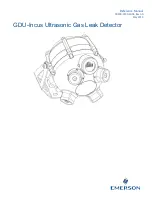
64171, Rev. 10/May 2019
3M™ GMI™ PS200 PORTABLE GAS MONITOR
ALARMS
4-1
4. ALARMS
4.1. Gas Alarms
When an alarm set-point has been reached, the audible, visual, and vibrating alarms will activate to
alert the users. All gas alarms are configurable to meet the specific needs of users and only operate
once the monitor warm-up is complete.
An alarm can be either ‘latching’ or ‘non-latching’. A ‘latching’ alarm will remain active until reset by
the user by pressing and holding the R button after the gas readings have returned to a safe level. A
‘non-latching’ alarm will reset automatically when the gas readings are safe.
4.1.1. FLAMMABLE LEL ALARM
Two alarm levels, ‘HI’ and ‘HIHI’, are available.
4.1.2. OXYGEN (O
2
) ALARM
Three alarm levels, HIHI, LO, and LOLO, are available.
4.1.3. TOXIC ALARM
The monitor calculates the Short Term Exposure Limit (STEL) and Long Term Exposure Limit (LTEL)
– known as Time Weighted Average (TWA) readings – for each toxic gas range. Each toxic range
has STEL and LTEL alarms, in addition to HI and HIHI alarms.
shows a ‘LOLO’ Oxygen alarm, and
Figure 4-1: O
2
LOLO Alarm
NOTE: A TWA value is the mean gas level exposure over a specific period. The STEL is 15
minutes and the LTEL is 8 hours. Usually, TWA alarms mean the monitor is for a sin-
gle user. For multiple user applications, an option is available to reset the STEL and
LTEL after each monitor switch-off.
NOTE: All alarm levels – HI, HIHI, LO, LOLO, STEL, and LTEL – are factory set . The user
must set the levels in accordance with their company’s procedures and with local
health and safety legislation. Alarm levels can be changed via the monitor set up
menu.
















































